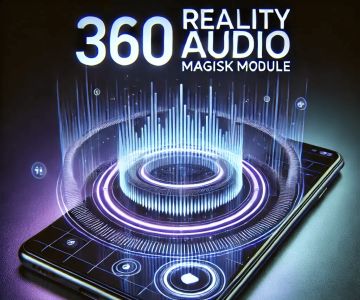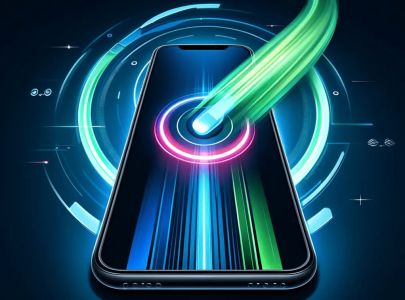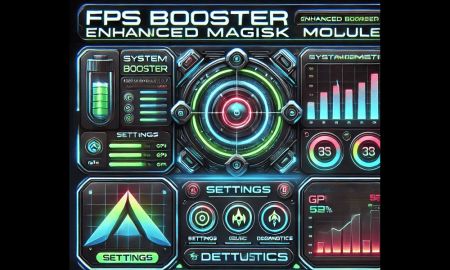Touch iOS Magisk Module to 144-165Hz Display Overclocking
.png)
The pursuit of smoother |WHILE MOST IOS DEVICES |
and more responsive displays |MOST IOS DEVICES OFFER |
has driven many tech |IOS DEVICES OFFER HIGH-QUALITY |
enthusiasts to explore the |DEVICES OFFER HIGH-QUALITY DISPLAYS, |
boundaries of what their |OFFER HIGH-QUALITY DISPLAYS, THERE |
devices can do. While |HIGH-QUALITY DISPLAYS, THERE IS |
most iOS devices offer |DISPLAYS, THERE IS ALWAYS |
high-quality displays, there is |THERE IS ALWAYS ROOM |
always room for improvement—especially |IS ALWAYS ROOM FOR |
in refresh rates. Typically, |ALWAYS ROOM FOR IMPROVEMENT—ESPECIALLY |
iOS devices like the |ROOM FOR IMPROVEMENT—ESPECIALLY IN |
iPhone feature 60Hz or |FOR IMPROVEMENT—ESPECIALLY IN REFRESH |
120Hz displays, with Apple’s |IMPROVEMENT—ESPECIALLY IN REFRESH RATES. |
ProMotion technology capping the |IN REFRESH RATES. TYPICALLY, |
refresh rate at 120Hz. |REFRESH RATES. TYPICALLY, IOS |
However, for those looking |RATES. TYPICALLY, IOS DEVICES |
to push beyond this |TYPICALLY, IOS DEVICES LIKE |
limit, the idea of |IOS DEVICES LIKE THE |
overclocking the display to |DEVICES LIKE THE IPHONE |
144Hz or even 165Hz |LIKE THE IPHONE FEATURE |
might sound enticing. This |THE IPHONE FEATURE 60HZ |
is where tools like |IPHONE FEATURE 60HZ OR |
Magisk come into play, |FEATURE 60HZ OR 120HZ |
but there’s a twist: |60HZ OR 120HZ DISPLAYS, |
Magisk is traditionally an |OR 120HZ DISPLAYS, WITH |
Android tool. So, how |120HZ DISPLAYS, WITH APPLE’S |
does it apply to |DISPLAYS, WITH APPLE’S PROMOTION |
iOS? Refresh rate refers |APPLE’S PROMOTION TECHNOLOGY CAPPING |
to the number of |PROMOTION TECHNOLOGY CAPPING THE |
times per second that |TECHNOLOGY CAPPING THE REFRESH |
a display updates its |CAPPING THE REFRESH RATE |
image, measured in Hertz |THE REFRESH RATE AT |
(Hz). Common refresh rates |REFRESH RATE AT 120HZ. |
include 60Hz, 120Hz, 144Hz, |RATE AT 120HZ. HOWEVER, |
and 165Hz, with higher |AT 120HZ. HOWEVER, FOR |
numbers indicating smoother and |120HZ. HOWEVER, FOR THOSE |
more fluid visuals. This |HOWEVER, FOR THOSE LOOKING |
is particularly beneficial in |FOR THOSE LOOKING TO |
gaming, where fast movements |THOSE LOOKING TO PUSH |
and quick reactions are |LOOKING TO PUSH BEYOND |
crucial, but it also |TO PUSH BEYOND THIS |
enhances the general user |PUSH BEYOND THIS LIMIT, |
experience by making animations |BEYOND THIS LIMIT, THE |
and transitions more fluid. iOS devices, particularly |LIMIT, THE IDEA OF |
the newer iPhones and |THE IDEA OF OVERCLOCKING |
iPads, come with high-quality |IDEA OF OVERCLOCKING THE |
displays. The introduction of |OF OVERCLOCKING THE DISPLAY |
ProMotion technology brought 120Hz |OVERCLOCKING THE DISPLAY TO |
refresh rates to these |THE DISPLAY TO 144HZ |
devices, offering a significant |DISPLAY TO 144HZ OR |
improvement over the standard |TO 144HZ OR EVEN |
60Hz. However, this is |144HZ OR EVEN 165HZ |
still below the 144Hz |OR EVEN 165HZ MIGHT |
or 165Hz that some |EVEN 165HZ MIGHT SOUND |
high-end Android devices and |165HZ MIGHT SOUND ENTICING. |
gaming monitors offer. For |MIGHT SOUND ENTICING. THIS |
users who crave the |SOUND ENTICING. THIS IS |
absolute best in display |ENTICING. THIS IS WHERE |
performance, the idea of |THIS IS WHERE TOOLS |
overclocking the display to |IS WHERE TOOLS LIKE |
achieve these higher refresh |WHERE TOOLS LIKE MAGISK |
rates is tempting, despite |TOOLS LIKE MAGISK COME |
Apple’s limitations. Magisk |LIKE MAGISK COME INTO |
is a popular tool |MAGISK COME INTO PLAY, |
in the Android community |COME INTO PLAY, BUT |
known for its ability |INTO PLAY, BUT THERE’S |
to modify system settings |PLAY, BUT THERE’S A |
without altering the core |BUT THERE’S A TWIST: |
system files—a method known |THERE’S A TWIST: MAGISK |
as “systemless root.” This |A TWIST: MAGISK IS |
allows users to tweak |TWIST: MAGISK IS TRADITIONALLY |
and enhance their device’s |MAGISK IS TRADITIONALLY AN |
performance while keeping the |IS TRADITIONALLY AN ANDROID |
device secure and stable. |TRADITIONALLY AN ANDROID TOOL. |
However, Magisk is traditionally |AN ANDROID TOOL. SO, |
not available for iOS. |ANDROID TOOL. SO, HOW |
That said, the concept |TOOL. SO, HOW DOES |
of using a tool |SO, HOW DOES IT |
to overclock a device’s |HOW DOES IT APPLY |
display, similar to how |DOES IT APPLY TO |
Magisk operates on Android, |IT APPLY TO IOS? |
raises interesting possibilities for |APPLY TO IOS? UNDERSTANDING |
iOS users. Overclocking |IOS? UNDERSTANDING REFRESH RATES |
an iOS display to |UNDERSTANDING REFRESH RATES AND |
144Hz or 165Hz could |REFRESH RATES AND THEIR |
offer several benefits: Overclocking |PER SECOND THAT A |
is not without risks. |SECOND THAT A DISPLAY |
These include: To even consider |RATES INCLUDE 60HZ, 120HZ, |
overclocking your iOS display, |INCLUDE 60HZ, 120HZ, 144HZ, |
several prerequisites must be |60HZ, 120HZ, 144HZ, AND |
met: After overclocking, |IN GAMING, WHERE FAST |
you’ll want to verify |GAMING, WHERE FAST MOVEMENTS |
that your display is |WHERE FAST MOVEMENTS AND |
operating at the new |FAST MOVEMENTS AND QUICK |
refresh rate: Once overclocked, |EXPERIENCE BY MAKING ANIMATIONS |
you can optimize your |BY MAKING ANIMATIONS AND |
device for better performance: If such a |IPHONES AND IPADS, COME |
method were possible, here’s |AND IPADS, COME WITH |
how you might overclock |IPADS, COME WITH HIGH-QUALITY |
your iOS display: Step 1: |COME WITH HIGH-QUALITY DISPLAYS. |
Get the link frim |WITH HIGH-QUALITY DISPLAYS. THE |
to our link. Step 2: |HIGH-QUALITY DISPLAYS. THE INTRODUCTION |
Install the module via |DISPLAYS. THE INTRODUCTION OF |
Magisk app. Step 3: Apply |THE INTRODUCTION OF PROMOTION |
the overclocking module, adjusting |INTRODUCTION OF PROMOTION TECHNOLOGY |
the display refresh rate |OF PROMOTION TECHNOLOGY BROUGHT |
to your desired level—144Hz |PROMOTION TECHNOLOGY BROUGHT 120HZ |
or 165Hz. Step 4: Reboot |TECHNOLOGY BROUGHT 120HZ REFRESH |
your device to apply |BROUGHT 120HZ REFRESH RATES |
the changes and test |120HZ REFRESH RATES TO |
the new refresh rate. Touch iOS |RATES TO THESE DEVICES, |
v2.3.1 [144-165hz] Touch |TO THESE DEVICES, OFFERING |
iOS v2.3.1 [60-120hz] If overclocking |DEVICES, OFFERING A SIGNIFICANT |
seems too risky: Overclocking an |BELOW THE 144HZ OR |
iOS display to 144Hz |THE 144HZ OR 165HZ |
or 165Hz, while theoretically |144HZ OR 165HZ THAT |
possible, comes with significant |OR 165HZ THAT SOME |
risks and challenges. While |165HZ THAT SOME HIGH-END |
the benefits of smoother |THAT SOME HIGH-END ANDROID |
visuals and enhanced gaming |SOME HIGH-END ANDROID DEVICES |
experience are appealing, the |HIGH-END ANDROID DEVICES AND |
potential downsides like device |ANDROID DEVICES AND GAMING |
damage and warranty voiding—are |DEVICES AND GAMING MONITORS |
serious considerations. For those |AND GAMING MONITORS OFFER. |
committed to pushing their |GAMING MONITORS OFFER. FOR |
device to the limits, |MONITORS OFFER. FOR USERS |
understanding the risks and |OFFER. FOR USERS WHO |
proceeding with caution is |FOR USERS WHO CRAVE |
essential.Introduction
Understanding Refresh Rates and |WITH APPLE’S PROMOTION TECHNOLOGY |
Their Importance
iOS |THIS LIMIT, THE IDEA |
Display Limitations
What is Magisk?
Benefits of Overclocking |TO IOS? UNDERSTANDING REFRESH |
iOS Displays to 144-165Hz
Risks and Considerations
Prerequisites Before |REFRESH RATES INCLUDE 60HZ, |
Attempting Overclocking
Verifying the |BENEFICIAL IN GAMING, WHERE |
Overclocked Refresh Rate
Optimizing iOS for |USER EXPERIENCE BY MAKING |
Overclocked Refresh Rates
Step-by-Step Guide to |THE NEWER IPHONES AND |
Overclock iOS Display Using |NEWER IPHONES AND IPADS, |
Magisk (Hypothetical)
Get |REFRESH RATES TO THESE |
Link
Alternatives to |THESE DEVICES, OFFERING A |
Overclocking on iOS
Conclusion
FAQs
|IS MAGISK? MAGISK IS |





